#that has been released in 1992 in Japan and 2009 in the rest of the world....
Text
I'm not sure Dragon Quest V has a fandom
I'm not sure if it has one that i want to meet it
But the world will have to see my yaoi!!!
#I SAW HARRY X MC FANARTS ON GOOGLE WHEN LOOKING FOR REFERENCES#woah.. truuue true#not me getting obsessed with a ship from a game#that has been released in 1992 in Japan and 2009 in the rest of the world....#Do you think i can make people play the game with my yaoi fanarts.. ahah#i need to find an other trans guy who could agree with my trans Harry x mc hc fr#Dragon Quest V: Hand of the Heavenly Bride (gender neutral)#you wouldn't get it.......#10yo me would be so proud#OFC MY FAV IS THE GREEN HAIR GUY OFC......
4 notes
·
View notes
Text
Where Have They Gone Now: Izzy Stradlin
Born Jeffrey Dean Isbell, the future guitar player for Guns N’ Roses was born and grew up in Lafayette, Indiana. He always held a fondness for the small-town life in Indiana. “It was cool growing up there. There's a courthouse and a college, a river and railroad tracks. It's a small town, so there wasn't much to do. We rode bikes, smoked pot, got into trouble—it was pretty Beavis and Butt-Head actually." His first instrument turned out to be the drums because his paternal grandmother played in a swing jazz band. Izzy started his first band in high school with a group of friends including a young man named William Bailey, who later became Axl Rose. Stradlin would later recall his first impression of Rose. “We were long-haired guys in high school. You were either a jock or a stoner. We weren't jocks, so we ended up hanging out together. We'd play covers in the garage. There were no clubs to play at, so we never made it out of the garage." He would go on to actually become the only member of GNR to graduate high school with a D average. Upon graduation, the future rhythm guitarist moved to Los Angeles in 1980.
Upon his arrival in LA, Stradlin joined the group, Naughty Women. During their first show, audience members began assaulting the band as they played. Izzy would later recall the incident. “I just grabbed a cymbal stand and stood on the side trying to fend them off, yelling, 'Get the fuck away from me, man!' That was my introduction to the rock scene in L.A." After two months, he left Naughty Women to join the punk band, The Atoms, which was short lived. During his time in that group, his drum kit was stolen, so Stradlin switched to the bass guitar. In 1983, he joined with Axl Rose to form the group, Hollywood Rose. They would go on to record a five song demo, but they eventually disbanded. He had a short stint with Sunset Strip local favorite London before reuniting with Hollywood Rose. In March 1985, they added more members to Hollywood Rose to become Guns N’ Roses.
As Guns N’ Roses began work on a first album, Stradlin emerged as the key songwriter for the album, Appetite For Destruction. He held a co-writer credit for almost every track on the album. At the time, this might have surprised some people as Izzy had garnered the reputation as a go to guy for really good heroin. He had become quite the addict himself as well. Yet, the guitarist was still able to function as a member of Guns N’ Roses at a very high level. In the band’s follow up EP, Lies, Stradlin also contributed by helping to write the track, “Patience.” Yet, the good times quickly went bad for the guitarist, when he was given probation for a year for urinating in the aisle of an airplane. This led him to making the decision to get sober going home to Indiana to detox from drugs and alcohol. Upon his return to the band, things were not quite the same. In 1991, Guns N’ Roses released Use Your Illusion I and II. The group was probably at the height of its fame during this time. Stradlin shocked the music world when following its release, he quit the band. His last performance with the band was in late August of that year at Wembley Stadium. He received songwriting credits for 10 songs on the new albums. In interviews, he would go on to say that he did not want to deal with the band drama any longer, but more specifically the antics of one Axl Rose. Another issue was the fact that other band members were trying to pay him less in royalties. “Once I quit drugs, I couldn't help looking around and asking myself, 'Is this all there is?' I was just tired of it; I needed to get out."
Following his surprising exit from Guns N’ Roses, Izzy Stradlin returned to his home town of Lafayette, Indiana. It was here that he began writing and recording new music. He formed the band Izzy Stradlin and the Juju Hounds, which included members of the Georgia Satellites and Broken Homes. Their first album, self titled, was released in October 1992. In the Rolling Stone review, they said it was a “thoroughly winning solo debut.” The band played their first show at the Avalon in Chicago that September. In May 1993, Stradlin would return to Guns n’ Roses to fill in for his replacement, Gilby Clark, who had an injured wrist. After that ended, Stradlin returned to the Juju Hounds for a tour of Japan. He would then take time off from any music-related projects.
In 1995, the guitarist began working on material for a new solo album. The album would not be released until 1998. Duff McKagan formerly of Guns N’ Roses played on the album. Much like his album with the Juju Hounds, Stradlin did absolutely nothing to promote the album. He would not do any interviews, no tour, and for the most part tried as hard as he could to stay out of the public eye. This was his last album with Geffen, as they dropped him from the label because he did not sell very many records. In December 1999, Stradlin released his third solo album, Ride on on the Universal Victor label. This time he would actually play four live shows to promote the album. Stradlin and his band would go on to record two additional albums, River in 2001, and On Down the Road in 2002. The latter album was a Japan only release. Around that time, he was asked by former bandmates, Duff McKagan, Slash, and Matt Sorum to join the supergroup Velvet Revolver. In the end, he decided not to join because of his dislike for life on the road and collaborating with a lead singer. Though, he did contribute to some early songs.
In the next few years, Stradlin turned out to be quite prolific in the release of new material. He released solo albums in 2005, 2007, 2008, and 2009. In 2012, Izzy was inducted into the Rock and Roll Hall of Fame as part of Guns N’ Roses. He released a statement thanking various people, but did not attend the induction ceremony. Stradlin would join Guns N’ Roses for a few shows later that year, but the guitarist ultimately decided not to return full-time. One of the sticking points was salary for the concerts not being split equally. He might have been offered guest appearances, but he would have declined those as well. Since then, Stradlin has only released a few singles and played guitar on a John Mellencamp album in 2017.
Izzy Stradlin is one of the most unique stories in the history of rock and roll music. Here is a guy, who walked away from fame, money, adulation, and did not think twice about it. He still lives in Lafayette, Indiana remaining a bit of a recluse to this day. The only time you hear from him is upon the release of any new music. Yet, it is interesting because you never hear him, but instead the only time you hear him talk at all is probably in his lyrics. In 2016, people did make a big deal out of the fact that he had joined Twitter. Stradlin has since deleted that account. The guitarist felt that the royalties he would earn for the rest of his life because of one album was good enough for him. Over the years, people had said that he was the coolest dude they have ever met in their entire life. Nothing ever phased him at all. I would say that is fairly accurate. Izzy Stradlin walked away from Guns N’ Roses and didn’t give a fuck what anybody thought about it.

10 notes
·
View notes
Text
MJJNews Provided By Anji~Justice240
MJJNEWS, PICKING -UP- WHERE WE LEFT OFF…
In Loving Memory Of Michael Jackson 1958-2009
♥ You Know That L.O.V.E. Survives ♥
** ♥ So We Can Rock Forever ♥ **
★January 2021★
MJJNEWS, PICKING -UP- WHERE WE LEFT OFF…

MICHAEL JACKSON – 2020 YEAR IN REVIEW
January 1, 2021

If someone had told you at the beginning of 2020 that the year was going to be spent mostly at home and online, you’d probably have laughed it off. However, in arguably the most challenging year of our lifetime, that’s exactly what happened. Thankfully, we’re fans of the King of Pop and that means that no matter where you are in the world, you’re part of an active community that engages fans and always finds ways to celebrate no matter how challenging.
So, before we turn the page to 2021, Here is MJVibe’s top picks for Michael Jackson 2020 – Year in Review!

Thriller appears in the Top 10 vinyl sales of the decade in the United States at number 6, having sold 334,000 copies between 2010 and 2019. In 2019 alone, 88,000 copies of Thriller on vinyl were sold across the U.S.

A pair of Louboutins designed exclusively for Michael to wear during ‘This Is It’ go on display in Paris France at the Palais de la Porte Dorée as part of an exhibition focusing on the world-famous designer Christian Louboutins. The sparkly shoes offer a subtle nod to Michael’s Triumph/Off The Wall look and were displayed as if Moonwalking.

- Bad in Wembley and Dangerous Live in Bucharest are once again made available for streaming on YouTube through Michael’s official channel in an effort to encourage the ‘stay home’ order given to countries around the world.
- After 11 years at the Lyric Theater, Thriller Live closes its doors for the final time. The show had been scheduled to complete on April 26th 2020 and leave the Lyric to find a new home. However, the UK-wide lock down as a result of the pandemic saw the show close earlier than planned.
- The MJ Estate donated $300,000 to Corona Virus relief efforts in Michael’s name. Broadway Cares, Three Square Food Bank (Southern Nevada’s largest hunger-relief organization) and MusicCares each received a $100,000 donation.

The Estate release ‘Heal The World 2020’, a new short film to accompany Michael’s 1992 hit of the same name. The film focused on the Covid-19 pandemic and was produced to unite Michael’s fans virtually during an almost global lock down.
In response to the release, fans ensured ‘Healtheworld2020’ trended two weekends consecutively. As of December 2020, the short film has 4.3 million views on YouTube.
View the video here!
youtube

- As a result of the pandemic, MJ The Musical’s debut is once again delayed to September 2021. Originally planned to open in Chicago in the Summer of 2019, the launch was cancelled with a plan to head straight to Broadway in early 2020. After three rescheduled dates, the decision was made to push to September 2021.
- Michael dominates Smooth Radio’s All-Time Top 500 Songs with the most entries by a solo artist. With 20 entries, Billie Jean and Man In The Mirror placed inside the Top 10, with George Michael being the only other artist to do so. Averaging four million listeners a week, Smooth Radio removed Michael from rotation in 2019, however, this poll as voted by the public, ensured Michael returned to the station’s regular playlist. #MUTEWHO?!

- HIStory turns 25 and while fans around the world mark the album’s monumental status and timeless appeal, the Estate chose to release apparel and a badge set, which mostly amounted to, what some fans considered an overpriced, bad quality, poorly designed, late delivered collection.
Judge for yourself, Ilia Mizani and Pez Jax sat down to review some of the products here.
- Marking the 25th Anniversary of the album, the HIStory teaser is added to YouTube where it has since been viewed 1.5 million times via Michael’s official channel.
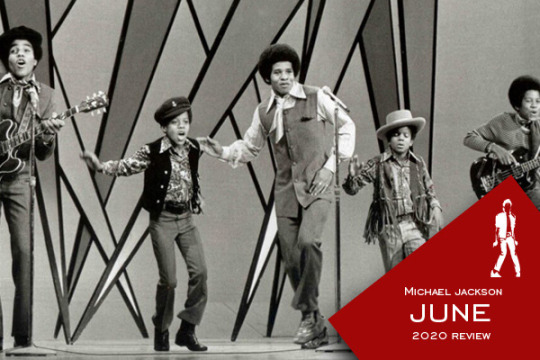
- It’s been over 50 years since the Jackson 5 performed on the Ed Sullivan show. As part of a full library upload, the performances are restored and uploaded to YouTube for future generations to enjoy. You can watch the iconic performances here!
- Sixteen11 Media Group announces the release of a new book titled, ‘The Story of HIStory’ by Pez Jax. The book charts the creation and release of HIStory and marks 25 years of the album’s release. Including interviews with many people who worked on the album and short films, Jax called upon HIStory Statue sculptor Diana Walczak to help create the cover of the book. By the end of 2020, the book was released in special gold hardback and has been shipped to over 30 countries around the world. Several of Michael’s items from the era were placed on auction through Julien’s Auctions. Taking place from the 15th – 19th of June, listings included the three Olodum outfits worn by Michael in ‘They Don’t Care About Us’, the black trench coat from Stranger In Moscow and the handwritten lyrics to D.S.

- Author Damien Shields releases ‘The Genesis of Thriller’, a special audio documentary that takes listeners into the studio to discover how the world’s biggest-selling album was made. HIGHLY Recommended!
You can listen to this insightful audio documentary here!
youtube

- SiriusXM launches ‘The Michael Jackson Channel’, a radio station playing nothing but Michael Jackson music for a strictly limited time. The station also featured a special playlist titled ‘The Now More Than Ever King of Pop Playlist’.

- UK Nationwide Radio Station ‘Smooth Radio’ host their annual ‘Top 100’ poll to find out who the number one Icon is, according to listeners. With an overwhelming number of votes, Michael comes in at Number one.

- Following global demonstrations in relation to the killing of George Floyd at the hands of police, Spike Lee teamed up with the Estate to release a new version of ‘They Don’t Care About Us’ for 2020. Mixing together both the Brazilian and Prison versions of the short film, Lee also incorporated footage from demonstrations around the world, which once again proved just how timeless Michael’s music is when used as the backdrop to current affairs.
Watch it here!
youtube
- Chinese fans celebrate Michael’s 62nd Birthday with the unveiling of 10 statues across the country. Created by MJJCN, the statues were installed in prominent locations including Nanning and Beijing and serve as a wonderful dedication to Michael.
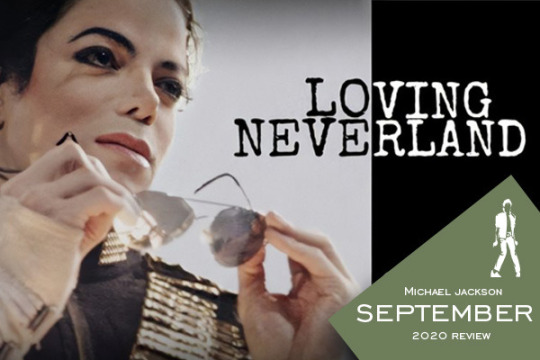
‘Loving Neverland’ is released on YouTube as a five-hour compilation of footage and information that details Michael’s life, challenges and career in great detail. Compiled by fans Nandita Raghav and Deboleena Aich, Loving Neverland serves as a powerful reminder to what Michael experienced for anyone looking to understand who he was. You can watch it here!
youtube
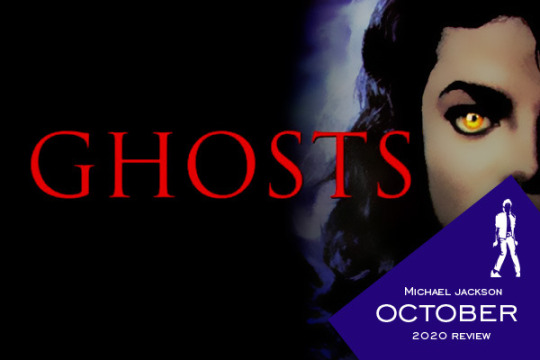
- Finally, and after many years of asking, the Estate decided to do something with Michael Jackson’s Ghosts, announcing it would be free to stream on YouTube from 29th October until the 1st of November. To mark the Halloween period, which Michael ultimately rules, the mini-movie was uploaded in better quality than the previous uploads.
- Walmart release a limited edition 2x colored vinyl of the Jackson 5 greatest hits album ‘The Ultimate Collection’. Available only in the U.S, the album was issued through Universal Music.

- In what’s almost yearly fashion, more of Michael’s personal items were placed up for auction including the 2006 Japan VMAs jacket that marked Michael’s first official red-carpet appearance since his 2005 trial.
Also on auction were platinum record awards, signed items, photographs, drawings and a glove.
- Cirque-Du-Soleil announced that despite being closed for most of 2020 due to the pandemic, Michael Jackson ONE is one of five Las Vegas residency shows to receive a contract extension. Originally signed as a 10-year with five years guaranteed at the Mandalay Bay, the show has been so popular that both Cirque and Mandalay want to keep it going past its 2023 end date. The new end date on the contract extension has not been announced.

- On November 16th, the legendary Bruce Swedien passed away. Having worked with Michael as Engineer on all his Epic solo albums up to Invincible, Swedien continued working in the industry up until his passing and became an inspiration to many upcoming producers and engineers. Rest in Peace Bruce!
- Michael once again topped Forbes list of the Highest-Paid Dead Celebrity. Coming in at number one with $48 million earned, he beat Dr Seuss who came in second position with $33 million. FYI, Elvis came in 5th.

- To cap off another year of insightful interviews and important documentation, the MJCast episode 126 was a special featuring TJ Jackson. TJ speaks about growing up a Jackson, working with Michael and how the last few years of negativity have affected his family. You can listen to this deeply personal episode here!

- On Christmas Eve it was announced that Neverland ranch had officially been sold. Purchased for just $22 million by Billionaire Ron Burkle, the final price was a huge reduction from the overzealous $100 million asking price when the property was first put onto the market. However, there is hope as Burkle was a former business associate and friend to Michael, so while it may not be a ‘Michael Jackson Memorial’, it will hopefully be treated with the respect and history it deserves.
As we begin 2021 with hope and optimism, it may take a while before we can all be back with our favorite MJ friends; throwing down dance moves on his birthday and lighting candles on his anniversary. However, with the 30th Anniversary of Dangerous and the 20th Anniversary of Invincible at the tail end of the year, it’s likely we can look forward to some exciting coverage from a variety of different places and hopefully some more chart-topping achievements throughout the year.
⭐༺★༻ ༺🖤༻ ༺★༻⭐
2 notes
·
View notes
Link
Beloved by the local blues community, Gray's long career included stints performing with Chicago stars Howlin' Wolf, Muddy Waters and Junior Wells.
A musician for more than 80 years, Gray performed throughout the United States, Europe and Japan. His festival performances included 39 appearances at the New Orleans Jazz and Heritage Festival as well as engagements at the Montreux Jazz Festival, the prominent King Biscuit Blues Festival in Helena, Arkansas, and the Chicago and Baton Rouge blues festivals.
“Henry’s music has put smiles on thousands of faces and will continue to enrich us all for many years to come,” said Grammy-winning Baton Rouge blues artist Chris Thomas King.
A Chicago resident from 1946 to 1968, Gray worked with many of the city’s classic blues artists, including Jimmy Reed, Jimmy Rogers, James Cotton and his fellow Louisiana natives Buddy Guy, Little Walter Jacobs and Morris Pejoe.
“To play Henry’s boogie-woogie style, you had to have that left hand like a hammer,” said Rob Payer, the host of blues, rhythm-and-blues and jazz programs at WBRH-FM. “He was also a gentleman, always so sweet and affable.”
Playing blues and rock ’n’ roll standards as well as his original songs, Gray typically performed a mix of joyfully up-tempo selections and heart-wrenching blues. His many honors included the National Endowment for the Arts’ National Heritage Fellowship Award he received in 2006. The Memphis-based Blues Foundation inducted Gray into its Hall of Fame in 2017, the same year it inducted Mavis Staples. In 1998, Gray received a best traditional blues album Grammy nomination for “A Tribute to Howlin’ Wolf.”
Although Gray’s 1998 performance in Paris for Rolling Stones singer Mick Jagger’s 55th birthday wasn’t a formal honor, it said much about his place in American music. Playing for the blues-loving British rock stars was a fun gig, Gray said, but the partying Stones wouldn’t let him get any rest.
“Kept me woke four days,” he told The Advocate in 1999. “They can’t sleep and they ain’t go let you sleep — not if they like you. They down to earth, good people, but they just crazy.”
Incidents such as the 1989 tornado strike that destroyed his house in north Baton Rouge and the city bus that crashed into his car in Chicago in 1951 earned Gray his nickname — Lucky Man. He served in the South Pacific during World War II and survived the 2016 flood that affected thousands of Baton Rouge area households. Floodwaters ruined his home, electric piano, clothes and 1994 Ford Crown Victoria. After his rescue by boat, looters stole the safe where Gray stored documents and valuables, including his Grammy-nominee medallion.
Born Jan. 19, 1925, in Kenner, Gray grew up in the East Baton Rouge Parish community of Alsen. A woman in his neighborhood taught him to play blues piano. His religious parents disapproved until his father realized Henry could earn money playing music.
Following his service in the U.S. Army during World War II, Gray returned to Louisiana, but didn’t stay long.
“I don’t pick no cotton, I don’t grow no corn, I don’t plow no mule,” he said. “My daddy put me out there, wanted me to chop corn. I cut my own good foot. I did it on purpose! I picked 60 pounds of cotton in my life, said that was it.”
In 1946, Gray moved to Chicago, a destination city for African Americans who left the South and brought the blues with them. He found a mentor in Big Maceo Merriweather, one of the city’s great piano men. “I was playing some blues, but not like I play now,” Gray said. “He showed me the fundamentals of the blues.”
Gray spent 12 of his 22 years in Chicago playing piano in blues star Howlin’ Wolf’s band.
“I was playing with Little Walter, Howlin’ Wolf, Jimmy Reed, a boy called Morris Pejoe, Elmore James, Sonny Boy Williamson,” Gray said in 1999. “See, I was playing with all of the big guys. I was making my money, too. I had plenty of work. Every night if I wanted to.”
In 1968, Gray left Wolf’s band and returned to Louisiana. He disputed accounts that Wolf fired him due to his drinking.
“That was over a woman,” Gray insisted. “I walked away. I went back to Baton Rouge. I was just as important as Howlin’ Wolf. That’s the way I felt. He may have been Howlin’ Wolf, but I was Henry Gray.”
In Baton Rouge, Gray worked in his family’s fish market and later as a roofer for the East Baton Rouge Parish school system.
Gray recorded for several record labels, including Chess Records in Chicago, APO, Telarc Blues, Bluebeat, Hightone, Wolf, Blind Pig and Lucky Cat. Three of his recordings are featured on the 1992 MCA box set “Chess Blues.”
In 2004, Gray released the DVD “Henry Gray & the Cats: Live in Paris.” The French audience treated his performance as if it were a classical recital in a world-class concert hall.
“Everywhere I go over there, they love the blues,” Gray said.
Gray is also featured with Dr. John in the Clint Eastwood-directed “Piano Blues,” an episode of the Martin Scorsese-produced 2003 PBS series, “The Blues.”
A songwriter as well as a singer and pianist, Gray’s original songs on his 2009 album, “Times Are Gettin’ Hard,” include “Barack Obama Boogie,” his homage to the first African American president. “He’s my man,” Gray sings. “If he can’t do it, can’t nobody can.”
Gray’s recordings include 2015’s “The Henry Gray/Bob Corritore Sessions, Vol. 1: Blues Won’t Let Me Take My Rest” and 2017’s “92.” Grammy-winning zydeco artist Terrance Simien, co-producer of “92,” met Gray at the 1984 World’s Fair in New Orleans.
“Just him and his piano,” Simien recalled. “Huge crowds gathered around him every time he played.”
Even while Gray appeared at festivals around the world, he played regularly at the Piccadilly cafeteria on Baton Rouge's Government Street for more than a decade. In his early 90s, Gray gigged at the Time Out Lounge every Tuesday for nearly three years. He refused to stop performing there despite a collapsed lung and a mild heart attack he experienced in quick succession.
Henry gave "it all he can every time,” said Time Out Lounge co-owner Kathleen Byers. “He’s a treasure to me. He should be a treasure to every person in Baton Rouge.”
“I’m going to stay playing my piano,” Gray vowed. “I got to take care of my own business.”
In a 1993 interview, Gray expressed his belief that blues as a musical genre would endure.
“Every person who’s ever been through anything, they’ve gotten the blues,” he said.
https://www.theadvocate.com/baton_rouge/entertainment_life/music/article_99a7dcb6-f450-11e9-8291-0742ebb5a887.html
4 notes
·
View notes
Text
An Introduction to Gothic Games
In this short essay, we’re going to take a layperson’s look at Gothic video games, how they draw on their literary predecessors, and what they offer to the genre that no other medium has managed.
The components of the gothic tale are at this point well-worn tropes in literature, comfortable to slip into and easy to digest. Gothic iconography – the mouldering manor, the decayed bloodline, the horrific creature – has become the symbol of mass-market consumerism, cropping up every October to implore us to purchase candy and decorations. Draculas and Frankenstein’s Monsters grin out from cereal boxes, while zombies creep their way out of film-screens and into works of literature where they did not originally exist, such as in Seth Grahame-Smith’s Pride and Prejudice and Zombies (2009). It should be no surprise that the largest grossing entertainment industry in the United States, the video game industry, also shares this preoccupation with the Gothic. Even before it ballooned to the size it is today, some of the earliest games were based upon the generic moves and tropes originated in gothic novels. In this paper, I will provide a brief overview of the history of “horror games” before examining several titles classified as such in the popular imagination, drawing from a broad range of years and developers, in order to comment on how some of the most popular titles utilize the conventions of the Gothic to produce works of interactive media.
The immediate and obvious difference between Gothic novels and games is the interactive nature of the latter, which faces the challenge of interface. This problem is not unique to the “horror” game genre – and throughout this paper I refer to games alternately as “horror” or “Gothic” interchangeably – but it has been handled differently from the vast majority of other genres by developers. When developing a video game, the primary goal of the developer, when designing the physical control scheme that one uses to play the game (be it mouse, keyboard, controller or other input) is to remove, as much as possible, any sense of friction between the player executing a command and their onscreen avatar carrying it out. This is primarily due to the fact that most modern video games are power fantasies – the player-character is the best soldier in the world, or a superhero, or a powerful wizard. Any time the player feels hindered in their control, it creates a psychological dissonance that disconnects him or her from the state of play and causes frustration. Over decades, a series of best practices has emerged so that, within a genre, designers understand what the easiest and most intuitive control schemes are. For horror games, however, this is less true, because unlike most other game genres, horror games are not empowerment fantasies. The protagonist of a horror game is often pursued by monsters, lost and confused, deprived of resources and subjected to all sorts of physical and psychological trauma from which they will be lucky to escape alive. As a result, many styles of control that have become obsolete over the years persist in horror. The most famous example of this creative choice are so-called “tank controls,” which feature as the control method for the first three case studies presented below. Tank controls are a form of avatar locomotion where, appropriately, the player-character controls like a tank: in order to change direction, the character must pivot in place to face the direction of intended movement before being able to step forward. The camera is static, and does not follow the player. This is in contrast to games where the player may press a directional input and their avatar will immediately move without first having to go through a pivoting process, and the camera dynamically changes angles to always be behind the avatar. The original reason for the tank control implementation was due to technological deficits: early three-dimensional environments utilized pre-rendered images generated on powerful computers that could be drawn to the screen on a lower-powered game console as static backgrounds. Because these backgrounds were, in essence, flat photographs, the camera could not move around without exposing the artifice of the game’s environment and breaking the illusion. As technology advanced and the ability to freely move the camera in a three-dimensional environment became standard, many horror game developers felt that despite their outdated design, the frustration of having to grapple with unintuitive controls increases the tension felt by a player, heightening their sense of stress and fear in hairy moments. Robin Hunicke’s MDA Framework[1] posits that games can be viewed through a triumvirate set of lenses that work together to create a unified experience: “the mechanics give rise to dynamic system behavior, which in turn leads to particular aesthetic experiences. From the player ís perspective, aesthetics set the tone, which is born out in observable dynamics and eventually, operable mechanics” (emphasis mine.) Interestingly, artificially restricting the player-character’s movement straddles all three categories. It is one thing to run from a monster, but it is quite another to do so with one’s metaphorical legs tied together. It is in the horror game genre that one of the golden rules of interactive design can be found suspended with frequency, acting as an exception that proves the rule: it is not always better to provide a frictionless control experience to players.

Example screen of Haunted House
The horror game genre began in earnest the 1980s, with an increasingly-rapid number of releases designed to scare players. One of the earliest of these titles is Haunted House (1981) for the Atari 2600. As will become apparent, the traditional Gothic locale of the haunted house was immediately seen as an attractive setting for staging a game, and the play of Haunted House involved attempting to escape from the titular house while avoid monsters like bats and ghosts – though the visuals were so primitive that it was unlikely any player would truly feel their spine tingling. A series of haunted house games followed, however, such as Terror House(1982, Bandai LCD Solar) and Ghost House (1986, SEGA Master System), while other horror titles looked directly to classic works of gothic literature for inspiration, producing games such as Castlevania (1986, Nintendo Entertainment System) and Frankenstein (1987, Commodore 64) adapting or drawing upon Dracula and Frankenstein respectively. While text-based games could do a reasonable job of evoking the sense of dread and foreboding that the Gothic has come to be known for, these were not popular in the marketplace, and most of the best-selling titles were held back by technical limitations. A limited amount of memory restricted the number of colors that could appear onscreen, causing monsters to be rendered as blobs that were difficult to parse or laughably cartoonish. Developers focusing on providing the player with compelling gameplay at the expense of the game’s theme led to titles like Castlevania trading scares for action. It was not until the early 1990s that the power of computers advanced to the point where games could focus on telling a complex narrative of any type through more than simply printing text on the screen – a crucial element in producing a “Gothic” video game.
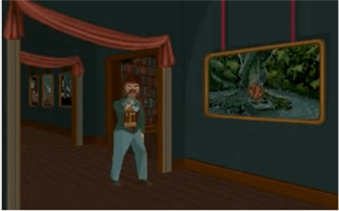
Carnby explores one of the haunted halls of Derceto
One of the forefathers of the modern horror game is the classic title Alone in the Dark (1992, DOS). The French developer Infogrames drew inspiration from the works of authors such as Edgar Allan Poe and H. P. Lovecraft in producing the title. Set in the year 1920, Alone in the Dark follows in the tradition of earlier haunted house games by trapping the player within the walls of the decaying Louisiana mansion Derceto. Taking on the role of an investigator [2] arriving at the mansion to determine what could have caused the prior owner, artist Jeremy Hartwood, to suddenly decide to take his own life, the player is drawn into intrigue surrounding the death of the mansion’s original owner, pirate Ezechial Pregzt, who was murdered during the civil war and now wishes to return to life to unleash all manner of terrifying beasts upon the unsuspecting world. From the roof of the mansion down into the system of caves below, the investigator must fend off supernatural assaults while working to lay Pregzt’s spirit to rest. The art direction of the game draws upon an aesthetic of romanticism, placing the investigators in an environment that, while not a natural wilderness (save for brief forays outside the manor’s confines,) still conveys via the environmental design a sense of untamed wildness, a darkness that is at once foreboding and irresistible. The manor itself is filled with haunts and ghouls, and the narrative climax, wherein the caverns below the house collapse, is reminiscent of the Fall of the House of Usher, despite the fact that Derceto remains standing for the player to continue exploring following the story’s conclusion, should he or she choose. Alone in the Dark spawned multiple sequels, but its most popular and famous progeny was not one of them. The most successful haunted house game of all time would come not from France but from Japan.
In 1996, Capcom released Resident Evil, known as Bio Hazard in Japan. Doubling down on the horror aspects, Resident Evil, much like Alone in the Dark, allows the player to select from either a male or female protagonist, both operatives with the task force S.T.A.R.S. investigating the disappearance of their fellows at a mysterious abandoned mansion on the outskirts of the Midwest town, Raccoon City. After being harried by dogs that would put the Hound of the Baskervilles to shame, the agents take refuge in the decaying house only to discover that it is infested with zombies. Making their way into the bowels of the mansion, they discover a conspiracy, contend with a traitor in their midst, and ultimately, as all Gothic manors must, the house collapses in on itself. Superficially, it appears that Resident Evil makes many of the same thematic moves as Alone in the Dark, relying on a mansion, supernatural phenomena within it, and a mystery to unravel to build tension. However, there are several factors that account for both this game’s mass-market success and its successful intervention into the Gothic genre. The same graphical improvements that had allowed Alone to stand out from its predecessors had, in the intervening four years, catapulted forward, and Resident Evil’s live-action opening before transitioning into then-cutting edge full three-dimensional explorable environments gave the title a cinematic flair unusual for the era. The second factor was the game’s narrative, unlike Alone in the Dark, grappled with social anxieties in a classic Gothic fashion. Fears over identity and betrayal from within sit alongside more modern tensions such as medical experimentation and government conspiracies.
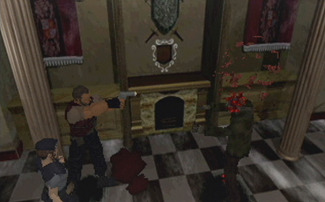
The protagonists of Resident Evil defeat one of many zombies.
These fears were alive and well not only in the Japanese psyche but worldwide, though within a few months The House of the Dead, another Japanese title involving special agents investigating a mansion full of zombies to uncover a medical conspiracy was blowing up arcades. As has been pointed out, the shift in zombie narratives from supernatural to scientific origin had been underway for some time, and although “it would be a challenge to pinpoint the exact moment,” critics have pointed to Night of the Living Dead, I Am Legend and the research of ethnobotanist Wade Davis for pushing zombies from magic to medicine. [3] The Resident Evil franchise continued into the present, branching out into box-office megahit films while becoming less gothic with each successive title, veering into more of a military fantasy with Resident Evil 4 during the years of the Iraq war when the enemies became infected foreigners, and staying there until 2017’s Resident Evil 7, which took the series back to its roots and harkened back to Alone – the setting is a Faulkneresque dilapidated southern plantation home where the darkness comes not primarily from the undead, but from the family that inhabits its collapsing structure – a redneck version of the Compson family, perhaps, but one that speaks to the class tensions in modern America. Resident Evil’s continual reinvention of itself demonstrates not only the ability of Gothic, as a genre, to take on whatever might be plaguing the collective unconscious of the era, but also how the anxieties of past Gothics – whether foreigners in Dracula or class in Wuthering Heights – return to the modern era wearing new clothing.
The horror game genre fully embraced anxiety and psychological manifestation three years after Resident Evil in the franchise Silent Hill. Expanding the haunted house concept to an entire abandoned town, the city of Silent Hill was notable for having a dual nature: the vaguely unsettling abandoned fog-filled streets would suddenly and without warning transform into an industrial nightmare world of rusting metal beams and horrifying monsters. While the story of a man searching for his lost daughter laid considerable worldbuilding groundwork, it was not until the sequel that the franchise reached its heights. Silent Hill 2 “features a woman’s blanched face on its cover, begins in an isolated, vile public toilet, and is about the spiritual purgatory of a grieving husband.”[4] Protagonist James Sunderland receives a letter from his wife, dead some three years, telling him that she is still alive, and that he must meet her in Silent Hill. When he arrives there, he finds his deepest repressions made manifest on the streets, constantly tormenting him. The environments are filled with hospital beds adorned with crisp white sheets and pillows, the monsters take the form of nurses and even a seemingly-real women he meets appears identical to his wife, despite having a wildly different personality.

James confronts his repressions in a straightforward manner
All the while, Sunderland is stalked by a violent and sexually aggressive creature known as “Pyramid Head.” Furthermore, other people trapped in Silent Hill appear to see the town completely differently – a teenage runaway named Angela, for example, perceives the town as being on fire, whereas Eddie, who has a history of violence, experiences the haunts not as nurses but as people laughing at and taunting him. As the player progresses through the narrative, it slowly becomes apparent that James’ wife did not die from an illness, but was smothered in her hospital bed by none other than James himself in an act that he himself is unsure how to classify – was it an act of mercy, or was it because he had come to resent the burden of caring for her? The trauma and repressed memories James grapples with created the Silent Hill that he experiences, and the murderous Pyramid Head grew out of James’ desire to be punished for his actions, and at the end of the game, with James now fully aware of his mental state, two Pyramid Heads commit suicide in front of him, their function no longer required. This banishment of the monster is a major differentiating factor that separates the gothic horror game from its literary progenitors: “While inhabiting Silent Hill… the challenge is to survive these monsters. Although you can run away from many of them, you cannot escape the boss monsters—you cannot if you wish to carry on your quest and continue to fall into the abyss of the player characters’ tortured souls. Unlike fiction where the question is “whether the creature can be destroyed” (Carroll 1990, 182), the player characters absolutely must destroy them or, for the Pyramid Head(s) of SH2, hold out long enough to make them kill themselves.” [5] The game can end in a variety of ways, ranging from James leaving Silent Hill in peace to following in the steps of Pyramid Head and driving his car into a lake. These variable ending states incentivize players to replay the game, finding different paths through the story in order to try and free James from his demons.
Unlike the Gothic novel, which must end in the way the author has written it, the ability for Gothic games to alter to fit the choices of their players allows designers to drive home psychological horror in a way books may struggle with: the characters descend into their own personal hells by the player’s hand and should they fail to emerge, it is the player’s fault. While readers may be complicit in the reading of a book with an unhappy or particularly traumatic ending, achieving a “bad” ending in a game, especially if a “good” ending is available, doubles the moral burden upon the player – not only are they complicit in acts of abuse against the fictional characters onscreen, but they also failed to guide the narrative to a positive conclusion. Some games, such as Until Dawn (2015) which features teenagers vacationing in cabin in haunted mountains, have made variable endings their main conceit. More of an interactive film than a traditional game, the player is presented with numerous split-second decisions to make with the goal of preserving the lives of every protagonist through the night – it is possible for them all to survive, or for each to meet a grisly death. If any of the protagonists fails to survive, the game drives home the guilt in the ending, as the rest weep about how they were not smart, strong, or fast enough to save their friend(s). Of course, it is the player who is the failure, and has caused the deaths of these teenagers - alongside, of course, the game designer, a puppetmaster who has orchestrated the scenario.
The final case study presented for examination is Amnesia: The Dark Descent (2010). Perhaps the most obviously Gothic of any game herein discussed, Amnesia is set in 1839 and follows the story of the London archeologist Daniel as he finds himself trapped within the walls of Brennenburg Castle in Prussia. Suffering from memory loss and terrorized by the castle’s inhuman inhabitants, Daniel seeks to regain his memories, discover why he inflicted amnesia upon himself, and ultimately escape from Brennenburg. Unlike the games discussed above, Amnesia is played from a first-person perspective instead of a third-person perspective, and more than any other is concerned with the generic convention of a gothic protagonist being disempowered.
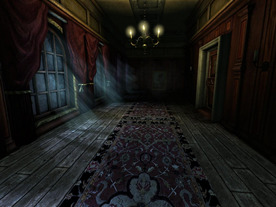
Brennenburg’s architecture appears like a modern version of Derceto.
Although it does not feature tank controls, Amnesia’s control scheme still aims to frustrate the player, as all actions must be completed in a realistic fashion. For example, whereas in most games all one needs to do in order to open the door is click on the door, in Amnesia the player must click and hold the mouse cursor on the door handle, then pull the mouse back as if they are pulling on a door. In a similar fashion, cabinets must be opened and closed, cranks must be turned, and drawers must be pulled. The ironic unintuitive nature of this control scheme (it too closely mimics real life physical object interaction for many players, and is considered tedious) causes the player to clumsily fumble with their objectives in tense moments when the game’s monsters are bearing down upon them. The second and perhaps most important way that Amnesia deals with disempowerment is via omission: unlike in any of the prior games discussed, there is no combat. While games such as Resident Evil or Silent Hill often discouraged fighting due to high enemy resiliency and low access to resources such as ammunition or health restoratives, Amnesia prevents combat entirely: if confronted by a monster, the protagonist’s only option is to run and hide, and being caught inevitably leads to a swift demise. Hiding itself is dangerous, however, due to the protagonist’s fear of the dark. If too much time is spent in dark places, the Daniel’s sanity will begin to drop and he will begin to whimper, drawing enemies to his hiding location or resulting in a game over due to going insane. Of course, lighting a match also alerts enemies to Daniel’s presence, so the player is in a constant state of tension, balancing Daniel’s sanity with his physical safety. Furthermore, as Daniel’s sanity drops, he begins to see and hear things that are not real, further confusing the player and making it unclear as to what is a real threat and what is simply an illusion of the mind. Developer Frictional Games’ innovation in showing it was possible to create an environment of Gothic disempowerment via an act of subtraction rather than addition, led to massive critical acclaim and revolutionized the way that horror games were made: both Silent Hills (a now-canceled title) and Resident Evil 7 changed their camera style to a first-person perspective and significantly scaled back their respective combat sequences, the latter even venturing into virtual reality to deliver more immersion and thus deliver more intense scares. Although “survival-horror” existed as a term describing a subgenre within horror games that focused more on stealth and puzzle solving than combat before Amnesia, the subgenre blossomed into its own with the title’s release.
What, then, can be concluded about the gothic genre as it manifests in video games as opposed to books? Obviously, the generalities related to the differing mediums apply – interactivity versus passivity, multimedia versus text, and so forth – but within Gothic specifically, placing horror games next to their literary counterparts reveals the strengths and weaknesses of the form. The kinesthetics of movement tied to play allow games to deliver to modern audiences a visceral feeling of tension more effortlessly than novels, though the written word excels at telling complex narratives that game storytelling still struggles to match. This is to be expected, of course – games are a young medium and the basic tools of signification are not fully understood. Although some would argue that “the best interactive stories are still worse than even middling books and films” and thus “if there is a future of games, let alone a future in which they discover their potential as a defining medium of an era, it will be one in which games abandon the dream of becoming narrative,[6]” horror games show that despite a lack of written narrative complexity to match older media, their ability to deliver narrative experiences on an emotional level – via engagement in an environment, be it solely through the physical manipulation of an onscreen avatar or through total sensory immersion in virtual reality – remains unmatched even at this early date. Gothic games may be the best evidence for this: their focus on the physical input device allows the mechanics, dynamics and aesthetics of a game to work together in a way most other genres do not achieve.
[1] Hunicke, Robin, Marc LeBlanc, Robert Zubek. MDA: A Formal Approach to Game Design and Game Research. Game Developer Conference, 2004.
[2] One potential choice for investigator, Edward Carnby, is named for Clark Ashton Smith’s John Carnby, a character found in “Cthulhu Mythos.”
[3] Jones, Tanya Carinae Pell. “From Necromancy to Necrotrophic: Resident Evil’s Influence on the Zombie Origin Shift from Supernatural to Science.” In Unraveling Resident Evil: Essays on the Complex Universe of the Games and Films, ed. Nadine Farghaly. McFarland & Company Publishers, Jefferson: North Carolina. 2014. 19.
[4] Alexander, Leigh. “Why Silent Hill mattered.” Offworld: 1 May 2015 (Web).
[5] Perron, Bernard. Silent Hill: The Terror Engine. Ann Arbor, MI: University of Michigan Press, 2011. 42-43.
[6] Bogost, Ian. “Video Games Are Better Without Stories.” The Atlantic. 25 April 2017.
#red pages podcast news#video games#videogames#horror#game design#indiedev#gamedev#gothic#literature#scary#spooky#amnesia#resident evil#silent hill#until dawn#alone in the dark
0 notes
Text
-Name: Lin Ting-Chun

-CV
NAME : Ting-Chun Lin
SEX : Male
DATE OF BIRTH : Apr 10,1980
PLACE OF BIRTH : Tainan, Taiwan
CITIZENSHIP : Tainan, Taiwan.
Office Address: Department of Neurology, Taipei Medical University Hospital
No. 252, Wu-Hsing Street, Taipei 110, Taiwan
Tel: +886 2 2737 2181 ext 8257
Email: [email protected]
Physician certificate No.:040467
LANGUAGE : Chinese, Taiwanese, English, Japanese.
EDUCATION :
1999-2006, Doctor of Medicine, Taipei Medical University, Taipei, Taiwan.
POST-GRADUATE EDUCATION :
1. Research Exchange of The International Federation of Medical Students’ Associations (IFMSA), Jul, 2005-Aug, 2005, Croatia.
2. 2007-2011, Neurology Residency & Fellowship;
Chang-Gung Memorial Hospital, Linkou, Taiwan.
3. National Taiwan University, College of Medicine, Graduate Institute of Clinical Medicine. PhD program.
EMPLOYMENTS :
Aug, 2013-now: Attending Staff, Department of Neurology,
Taipei Medical University Hospital
Aug, 2012- Aug, 2013: Attending Staff, Department of Neurology,
Chang-Gung Memorial Hospital, Jiayi, Taiwan
Aug, 2011- Aug, 2012: Fellowship, Department of Neurology,
Chang-Gung Memorial Hospital, Jiayi, Taiwan
Aug, 2007- Aug, 2011: Resident Physician, Department of Neurology,
Chang-Gung Memorial Hospital, Linkou, Taiwan
BOARD CERTIFICATION: Oct, 2012, Specialist in Neurology, Certification No.: 0967
MEDICAL LICENSE : Taiwan License No. 040467
PROFESSIONAL AFFILIATIONS :
1. Neurological Society, Taiwan
2. Formosan Medical Association, Taiwan
3. Taiwan Stroke Association, Taiwan
4. American Academy of Neurology, USA
5. American Heart Association, USA
RESEARCH INTEREST :
1. Cerebrovascular disease.
2. Thrombolytic therapy in stroke.
3. Neural stem Cell therapy.
PUBLICATIONS :
1. Treatment of neuropathic pain in acute intermittent porphyria with gabapentin
Ting-Chun Lin, Shiao-Lin Lai, Shih-Pin Hsu, and Long-Sun Ro
Journal of the Formosan Medical Association. (SCI), 2013 Sep;112(9):578-9. doi: 10.1016/j.jfma.2013.04.011. Epub 2013 Jun 2.
2. The impact of intracranial carotid artery calcification on the development of thrombolysis-induced intracerebral hemorrhage
*Ting-Chun Lin, MD; *Tzu-Hao Chao, MD; Yao Shieh, Prof.; Tsong-Hai Lee, MD, Prof.; Yeu-Jhy Chang, MD; Jiann-Der Lee, MD; Tsung-I Peng, MD, Prof.; Ku-Chou Chang, MD; Ting-Yu Chang, MD; Chien-Hung ChangMD, MS. *These authors contributed equally to this article.
Journal of Stroke & Cerebrovascular Diseases (SCI), Volume 22, Issue 8, November 2013, Pages e455–e462
3. Intracerebral hemorrhage after thrombolytic therapy in acute ischemic stroke patients with renal dysfunction
*Ting-Chun Lin, *Tzu-Hao Chao, Tsong Hai Lee, Yeu Jhy Chang, Yao Shieh, Jiann-Der Lee, Tsung-I Peng, Ku-Chou Chang, Hsiang Yao Hsieh, Chien Hung Chang. *These authors contributed equally to this article.
European Neurology (SCI), 2013;70(5-6):316-21. doi: 10.1159/000353296. Epub 2013 Sep 27.
4. Bilateral Paramedian Thalamic Infarction Presenting as Status Epilepticus: A Case Report and Review of the Literatures.
Sheng-Feng Lin, Ting-Chun Lin, Han-Hwa Hu, Chin-I Chen
Acta Neurol Taiwan 2015;24:125-130
5. Timing of symptomatic infarct swelling following intravenous thrombolysis in acute middle cerebral artery infarction: a case control study
Ting-Chun Lin, MD; Jiann-Der Lee, MD; Ya-Hui Lin, MD; Rey-Yue Yuan, MD; Hsu-Huei Weng, MD, MPH, PhD; Ying-Chih Huang, MD; Meng Lee, MD; Chih-Ying Wu, MD; Huan-Lin Hsu, MD, Chia-Yu Hsu, MD, Tsong-Hai Lee, MD, PhD; Shan-Jin Liu, MD;Yeu-Jhy Chang, MD;Chien-Hung Chang, MD; Tsung-I Peng, MD, PhD; Chia-Wei Liou, MD;Ku-Chou Chang, MD;Yi-Ting Pan, MD;Yen-Chu Huang, MD.
Clinical and Applied Thrombosis/Hemostasis2016 Jul 21. pii: 1076029616659693. [Epub ahead of print]
-Research Plan
Title: The long-term care in Taiwan.
The advantage of medical care improve the life expectancy worldwide and the care system for aging papulation is a big issue gradually. In 1993, more than 7% of the population in Taiwan was 65 years old or older and it is estimated that by 2018 Taiwan will cross the threshold into an aged society. In the near future by 2025, Taiwan will enter the era of a super-aged society. Like other countries, there are national policies for the long-term care systems, however, in Taiwan an integrated system is still under constructed. My plan might focus on the long-term care system that is established for the fragile seniors.
Developed countries have seen a steep rise in chronic conditions, and the trend will continue. A rise in chronic conditions and functional limitations will create a growing demand for long-term care services in the developing world as well. Although medical care boost the life expectancy, the number of seniors who suffered from several chronic degenerative diseases, such as dementia, Parkinson’s disease and other comorbidities, increases. The estimated number of people with dementia in Taiwan in 2012 was approximately four times that in 1992, increasing from 50,970 (3.6%) to 208,012 (8.0%). According to the Taiwan Ministry of Interior and the epidemiological study of dementia published in 2014, more than 130,000 older adults in Taiwan are suffering from mild to severe dementia. The elderly, people 65 years of age or older, are the primary clients of long-term care. Therefore, a comprehensive care system for the elderly including the long-term care system cannot be overlooked. There is no straightforward definition that can fully capture the nature of long-term care. This is because a broad range of clients and services are involved. Yet, certain characteristics are common to all long-term care services. Long-term care can be defined as a variety of individualized and well-coordinated total care services that promote the maximum possible independence for people with functional limitations and that are provided over an extended period of time, using appropriate current technology and available evidence-based practices, in accordance with a holistic approach while maximizing both the quality of clinical care and the individual’s quality of life. The long-term care delivery system has three major components, the informal system, the community-based system and the institutional system. The goal of long-term care is to enable the individual to maintain functional independence to the maximum level practicable. In addition,the idea of community-based support system or aging inplace is emphasized, in Japan as well as Taiwan, not only because of the cultural considerations but also concernabout the increasing number of fragile seniors. On the other hand, a rapidly declining fertility rate also aids the speedy aging in Taiwan. According to the Health Promotion Administration, Ministry of Health and Welfare 2014, in the end of 2013, average life expectancy was 79.9 years (76.7 years for men and 83.3 years for women) and the fertility rate in 2013 was only 1.1. How to relieve the burden of family caregivers has become a major challenge. The primary policy of the long-term care system is the 10-Year Long-Term Care Program that was proposed in 2007. In 2008, in response to a rapidly aging society and a labor shortage, the The Minister of the Interior (2008) released White Paper of Population Policy: Policies for pro-natal, aging, and migration. Furthermore, in 2009, the Taiwan government released Program of Friendly Care for Senior Service on the health of older adults, which highlighted three themes to guide the action plans: active aging, aging friendly, and intergenerational cohesion. Currently, the Ministry of Health and Welfare is drafting White Paper for Aged Society, which plans to collaborate with private sectors in Taiwan to provide community-based of prevention in primary care for older adults in an aged society. However, aging issues still seem a subfield in most academic disciplines and industries. In contrast with the Japan, there is no national institute concentrating on aging study in Taiwan. The research projects on aging are conducted at various public and private institutions, including universities. This might contribute to overlap and lack of coordination between research projects and services. To balance the medical care and long-term care system would be challenging.
Today, many countries such as Germany and Japan have universal, comprehensive long-term care systems based on social insurance. Japan have developed public universal long-term care insurance systems that are operated by the government. Nonetheless, both countries have trouble coordinating services between medical care and long-term care. Quality control is always a concern: Germany has stressed building quality into contracts between insurers and providers, while Japan emphasizes training. The German and Japanese governments both hoped, along with gerontologists around the world, that improving care in the community would lower nursing home usage and spending. However, this has not occurred. In Germany, the proportion of beneficiaries who receive institutional care has been increasing, from 27 percent in 1997 to 31.5 percent by 2005, including many who require only low levels of care. In Japan, demand for nursing homes exploded with the new program. The long-term care delivery system cannot function independently of other health care services. Hence, the long-term care system must be rationally linked to the rest of the healthcare delivery system. Lon-term care patients, regardless of where they may be residing, frequently require a variety of services along the health care continuum, dictated by the changes in the patient’s condition and episodes that occur over time.
-Social Issues and the Research
Many countries introduced comprehensive long-term care system because their frail older populations were growing; their traditional resources for care were declining; and their existing fragmented long-term care programs were increasingly seen as costly, inefficient, and unfair. The situation in the Taiwan today is similar, if not worse. Currently, the policies on long-term care in Taiwan are tied to the concepts of aging in place and community care services. The primary policy of the long-term care system in Taiwan was released in 2007. The second version is revising now. The primary challenge facing the long-term care system is the lack of both family and paid caregivers and their lack of professional training. In addition, too few potential recipients have requested long-term government services because services are not flexible enough, and some needy recipients do not meet the official qualifications. Although the complex of the long-term care program, I would investigate this object to comprehend the long-term care system and make it locally practicable in Taiwan.
- GCL plan in 2018
1) complete the long-term care program.
2) school myself with Japanese and English.
3) make a good collaboration with GCL members.
0 notes
Text
Dream Big, Princess
A Feminist Defense of Disney
Thank you so much for opening up this discussion. As a feminist growing up in the late 1990’s and early 2000’s, I have enjoyed the evolution of heroines throughout my childhood. Growing up, I enjoyed movies like Kiki’s Delivery Service and Spirited Away that featured strong woman protagonists. However, I found that the protagonists of some of these films could be problematic for me. Chihiro of Spirited Away was a particular problem for me as I found her to have a whiney, Luke Skywalker-esque quality to her character. While her character develops, she develops in this idea of the strong, independent woman; a toxically masculine idea that will be touched upon later.
You do bring up a good point though when it comes to finding heroines that want something more out of life than marriage, like Belle, who is desperate to leave the small-town thinking of her village. Her newest incarnation even has her shown as an inventor and innovator as much as her father is, which is important because this is the version of Belle that today’s children are the most familiar with.
I, too, wish that there were more characters like Pocahontas, fighting for the protections of the environment and the land she lives on while using her literal moral compass to stand for what is right with passion. On top of this, she was smart enough to encourage a relationship between her tribe and the settlers that allowed them to be respectful and compassionate toward each other and the land they are using to support their lives. She did all of this too, while rejecting an arranged marriage set up for her by the men of her tribe (Pocahontas, 1995).
While I will admit that Disney does have a penchant for removing family members, this tradition came long before they started making fairy tales into movies. This trope of broken families or lost parents often serves as a setup to insert and introduce the villain of the story. Step-parents, adoptive parents, and the like are very often the cause of turmoil in a heroine’s story. These original stories from medieval (or earlier) writers were meant to teach children life lessons in a way that was “safe” for children. To learn more, please see Bruno Bettelheim’s The Uses of Enchantment. However, most of those stories from Disney are their early and traditional films. Today, we have Rapunzel who, while separated from her parents, found them and was supported by them, only because of their ongoing love and support demonstrated through the release of lanterns on Rapunzel’s birthday. These lanterns served as motivation for Rapunzel to find a way out of her tower and see the world and see those lanterns that she had watched from afar for eighteen years (Tangled, 2010). We also have Mulan, whose biggest fear was disappointing her family and parents. She has both of her parents, and is supported by her father when he tells her that “the greatest gift and honor is having [her] as a daughter” after she has just been publicly dishonored for failing in her meeting with the matchmaker (Mulan, 1998). Most recently, we also have a heroine that not only has both parents, but a grandmother as well who serves as a spiritual guide throughout the heroine’s journey (Moana, 2016).
This also brings calls into question the idea of representation and why it matters. To call for heroines that have an intact family structure, is to call for the invalidation of young viewers who do not share this family structure. To make that call is to say that having two supportive parents is the only way to succeed or achieve anything, but the harsh reality is that this family structure is not the only one that exists, and we cannot ignore that. There are many separated parents, widowed parents, or absent parents in the real world. What began as a trope to move plot forward in stories coming from as early as 9th century China, has now become a mode of inclusive representation for young viewers of these Disney films.
While we are on the topic of representation, Disney is also often under fire for whitewashing their stories. For the earliest three princesses, this may be true. However, those stories take place in times and parts of the world that are generally seen as predominantly white. Meanwhile, after the thirty-year hiatus of Disney princess films, only the first two of what is considered the “Disney Renaissance” were white. The heroines of films released by Disney between the years of 1992 and 1998 were people of color, with the exception Megara from Hercules, which takes place in Greece and is considered as “white passing”. Ten years later with the release of The Princess and the Frog Disney introduced another woman of color as its heroine, and since then, Disney has looked for stories to create from different parts of the world, to make their stories more inclusive so that people feel connected to and represented within these stories. This concept of whitewashing is particularly evident in Miyazaki’s films. Coming from Japan, where paleness is the epitome of beauty and the ultimate goal for most, his films, while they are brilliant and beautiful storytelling, lack diversity.
Most importantly, we have the concept of imagination, innovation, and creativity, particularly aimed at a goal other than finding a husband. For me, Merida’s plan to get out of marriage was extremely imaginative and innovative – she used her skills and her strengths to fight for herself because no one else would. She went on an entire journey to get out of the prospect of an arranged marriage to one of the suitors presented by the lords of her kingdom. There is also Tiana who is imaginative, innovative, and deliciously juxtaposed to her best friend Charlotte. Charlotte in this film epitomizes the ideas that Disney had been criticized for presenting up until 2009 when they released The Princess and the Frog. Tiana uses her imagination and innovation to dream up a restaurant, that she does eventually get to open, and even just survive while she is a frog in the bayou because of the mistake of a man.
There has been a long line of Disney heroines with strong morals and the courage to act on them, and they have been the most guiding in my life. Ariel, before meeting Prince Eric, wants nothing more than to learn about a culture different from her own and repeatedly contests her father’s blind dislike for humans (The Little Mermaid, 1989). A few years later, Jasmine defied not only her father, but the laws and traditions of the land by refusing to meet with suitors from across the globe – who were only there because a law stated that she needed to marry before her next birthday. Jasmine rejected the role of a pawn in the games of men, giving a generation of women a moment of recognized self-worth when she states, “I am not a prize to be won” (Aladdin, 1992). Jump ahead again to The Hunchback of Notre Dame and we get Esmeralda, a woman persecuted by a man who only wants to have sex with her. She continuously stands up to this man and acts against him and the way he treats anyone has a categorized as “other” or “less” (1996). Jump ahead again and you land on Moana. She denies her father and the traditions of her island in order to save it. She goes on a quest in an attempt to correct the mistakes made by a man looking for attention, recognition, and power (2016). We also see a uniquely woman-centric moment of empowerment in Frozen; these two sisters teach young girls the importance of sisterhood and the importance of women supporting women, especially in a society so eager to set women up against each other (2013).
There are still some heroines that have been left unmentioned. Why? Not because they are unimportant or there is nothing we can learn from them, but because it is true that their stronger qualities are not as apparent as their more passive ones. Snow White (1937), Cinderella (1950), and Sleeping Beauty (1959) are likely the most passive heroines that Disney has ever or will ever produce, but what can we learn from them? All of them were after a life that was different or better than what they had. Snow White was chased from her own home by an evil, jealous queen, she was too trusting and therefore teaches us to be wary of the world and who we meet in it. Cinderella was heinously mistreated by Lady Tremaine and her two daughters and still remained kind. What is the importance of kindness and what kind of life can we lead when we meet the world with kindness, even knowing what kind of wickedness exists therein? Sleeping Beauty simply wanted the freedom to follow her heart and make decisions for herself, which at the end of the day is a pretty basic desire.
It is important to state as well that the “Disn-ification Process” is entirely up to the discretion and responsibility of the parent. However, Disney takes their role in a child’s development very seriously, as we can in their new movies and television programming. Many of the young girls I know are not even familiar with the original Disney iteration of the most passive heroines. Snow White, Cinderella, and Aurora are rarely given screen time for their original films. But, they do appear in Disney’s programming for children. Sophia the First features lessons of anti-bullying, self-worth, and empowerment for young girls taught by early princesses. Today’s programming also features a show Doc McStuffins, who dreams of being a doctor while still attending her ballet classes. All of this, I think, is pretty progressive for children’s programming, and that was all before this month’s announcement of an openly gay primary character on one of Disney’s after school programs that already covers the topics of non-traditional family structures, unplanned pregnancies, and other struggles of being in middle school. Over the last several years, Disney has not only developed more progressive and inclusive storylines, but they have set the standard for the rest of the industry. They are responsible for changes to the industry that are shaping the way we write about women for children of all ages.
Why in today’s society do we find stories about falling in love to be a distasteful anti-feminist act? One of feminism’s most prominent platforms is love for all; to give everyone with freedom to fall in love and get married (if they so choose) without denial or persecution.
Why is it that a feminist heroine must demonstrate masculinity? That trend of toxic masculinity becomes problematic for all genders because it promotes the repression of emotion and a refusal to communicate and share the load. Let us take a look at some of Disney’s more male-centric stories for this example. Disney has showed the dangers of the rigid and overly militant toxic masculinity in its portrayal of the evolving relationship between Captain Jack Sparrow and Commodore James Norrington. Jack is a man marked as a pirate. Why? Because he freed slaves. James is a man brought up on the belief that pirates are the scum of the earth and that no act of compassion or kindness can redeem them (re: Jack saved the life of the woman James loved and he still clapped Jack in irons). While Jack’s motivations are questionable at best, he finds himself in the position to make decisions that will either benefit him or a larger group of people, he usually picks other people. James can only see Jack as the self-serving and law-breaking pirate (neither of these facts are untrue), which makes it easy to maintain a disdain and contempt for him. However, James falls into the toxically masculine trap of an idea that what he is doing is right solely because it is being done in the name of the law. That is dangerous because it allows him to justify putting a large population of people (pirates) in danger by turning the heart of Davy Jones over to the head of the trading company that happens to be controlling the British navy. This blind faith in the law and in himself does not allow for self-reflection until a feminine character (Elizabeth) calls him out. That is a toxic quality that is seen all too often in hero characters, as well as these new “strong, independent female protagonists” like Katniss from the Hunger Games or Tris from the Divergent Series who are stripped of their femininity in order to be heroines.
But when did we get the idea that being feminine and enjoying one’s femininity are inherently anti-feminist? Those two ideas of being feminine and being feminist are not mutually exclusive ideas. A girl that loves pink is not a bad feminist. A girl that likes princesses is not a bad feminist. Princesses are not an anti-feminist idea. It is princesses that lead me to other works of fantasy. They fostered my deep love of storytelling and my appreciation and respect for the works of Joseph Campbell and Samuel Beckett. These princess movies can do for kids today what superhero comics did for children years ago, and Disney knows it.
#disney#disneyprincess#feminism#feminist#disnerd#ariel#snow white#cinderella#aurora#sleeping beauty#the little mermaid#beauty and the beast#belle#aladdin#jasmine#pocahontas#tiana#princess and the frog#rapunzel#tangled#esmeralda#hunchback of notre dame#hercules#megara#mulan
0 notes
Text
Whatever Happened To My Youth: Izzy Stradlin
In 1991, Guns N’ Roses released Use Your Illusion I and II. The band was probably at the height of its fame during this time. Rhythm guitarist Izzy Stradlin shocked the music world when following its release, he quit the band. He had been a key songwriter on the band’s previous effort, Appetite for Destruction. Stradlin also received songwriting credits for 10 songs on the new albums. In interviews, he would go on to say that he did not want to deal with the band drama any longer, but more specifically the antics of one Axl Rose. Another issue was the fact that other band members were trying to pay him less in royalties. The question now is what happened to Stradlin after that because he became a bit of a ghost in the music world.
Following his surprising exit from Guns N’ Roses, Izzy Stradlin returned to his home town of Lafayette, Indiana. It was here that he began writing and recording new music. He formed the band Izzy Stradlin and the Juju Hounds, which included members of the Georgia Satellites and Broken Homes. Their first album, self titled, was released in October 1992. In the Rolling Stone review, they said it was a “thoroughly winning solo debut.” The band played their first show at the Avalon in Chicago that September. In May 1993, Stradlin would return to Guns n’ Roses to fill in for his replacement, Gilby Clark, who had an injured wrist. After that ended, Stradlin returned to the Juju Hounds for a tour of Japan. He would then take time off from any music-related projects.
In 1995, the guitarist began working on material for a new solo album. The album would not be released until 1998. Duff McKagan formerly of Guns N’ Roses played on the album. Much like his album with the Juju Hounds, Stradlin did absolutely nothing to promote the album. He would not do any interviews, no tour, and for the most part tried as hard as he could to stay out of the public eye. This was his last album with Geffen, as they dropped him from the label because he did not sell very many records. In December 1999, Stradlin released his third solo album, Ride on on the Universal Victor label. This time he would actually play four live shows to promote the album. Stradlin and his band would go on to record two additional albums, River in 2001, and On Down the Road in 2002. The latter album was a Japan only release. Around that time, he was asked by former bandmates, Duff McKagan, Slash, and Matt Sorum to join the supergroup Velvet Revolver. In the end, he decided not to join because of his dislike for life on the road and collaborating with a lead singer. Though, he did contribute to some early songs.
In the next few years, Stradlin turned out to be quite prolific in the release of new material. He released solo albums in 2005, 2007, 2008, and 2009. In 2012, Izzy was inducted into the Rock ‘n’ Roll Hall of Fame as part of Guns N’ Roses. He released a statement thanking various people, but did not attend the induction ceremony. Stradlin would join Guns N’ Roses for a few shows later that year, but the guitarist ultimately decided not to return full-time. One of the sticking points was salary for the concerts not being split equally. He might have been offered guest appearances, but he would have declined those as well. Since then, Stradlin has only released a few singles and played guitar on a John Mellencamp album in 2017.
Izzy Stradlin is one of the most unique stories in the history of rock ‘n’ roll music. Here is a guy, who walked away from fame, money, adulation, and did not think twice about it. He still lives in Lafayette, Indiana remaining a bit of a recluse to this day. The only time you hear from him is upon the release of any new music. Yet, it is interesting because the only time you hear him talk at all is probably in his lyrics. In 2016, people did make a big deal out of the fact that he had joined Twitter. Stradlin has since deleted that account. The guitarist felt that the royalties he would earn for the rest of his life because of one album was good enough for him. Over the years, people had said that he was the coolest dude they have ever met in their entire life. Nothing ever phased him at all. I would say that is fairly accurate. Izzy Stradlin walked away from Guns N’ Roses and didn’t give a fuck what anybody thought about it.

2 notes
·
View notes